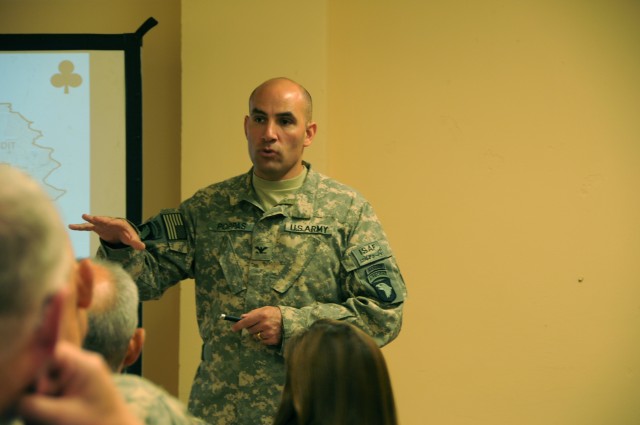
FORWARD OPERATING BASE FENTY, Afghanistan -Nearly than 50 civilian and military officials gathered to share "best practices" and coordinate their efforts to boost eastern Afghanistan's agri-business sector at Forward Operating Base Fenty Sept. 6.
Representatives from the U.S. Department of Agriculture, the U.S. Agency for International Development and their various implementing organizations met with military leaders from the three National Guard Agri-Business Development Teams serving the eastern Afghanistan provinces of Nangahar, Laghman and Kunar, which are all in the Task Force Bastogne area of operations.
Physical security and food security in Afghanistan are closely linked, according to TF Bastogne commander U.S. Army Col. Andrew P. Poppas of Janesville, Wis. During remarks to conference participants, Poppas also emphasized that kinetic operations are not enough to achieve success in his area of responsibility.
"Organizations devoted to improving the Afghan agriculture sector have a crucial part to play in our efforts," Poppas said. "We can clear and kill anti-Afghan forces. It's what we do. But we have to have the right governance and development projects to follow on behind us so we can enable the stability and sustainability of the Afghan government."
Joint military and civilian efforts are critical to achieving U.S. goals in Afghanistan, added Kate Byrnes of Sarasota, Fla., the senior civilian representative to TF Bastogne. However, Byrnes told conference attendees that real progress in Afghanistan depends upon military and civilian authorities going beyond simple cooperation and toward a true strategic partnership.
"It's not just about military and civilian cooperation," said Byrnes. "We know how to do that. We've been doing that for nine years. Where we can really make a difference is working together toward an end-state that creates the conditions for the success of the Government of the Islamic Republic of Afghanistan."
One organization that has worked to build strategic partnerships with agencies working on Afghanistan's agriculture sector, including the National Guard ADTs, is the Accelerating Sustainable Agriculture Program. ASAP, which is implemented for USAID by Chemonics International, Inc., has put a wide range of programs into place to improve the production, quality and marketing of high-value Afghan agricultural products, like grapes, cashmere wool and apples.
"We can't do what we do without the ADTs," said Joseph Daniel Moody, ASAP's Chief of Party. "One of ASAP's initiatives last year resulted in Afghanistan exporting its apples to India for the first time. That was only possible with the help of the ADT in Paktya Province."
A half-dozen USAID implementing organizations like ASAP gave presentations aimed primarily at the ADTs represented at the conference, including the Missouri National Guard's ADT IV, which works in Nangahar Province, the Kansas National Guard's ADT II, which works in Laghman Province, and the Iowa National Guard's 734th ADT, which works in Kunar Province. Both the Missouri and Iowa ADTs arrived in Afghanistan within the last three months.
"This conference has been especially worthwhile for the ADTs that are in the first portion of our tour," said U.S. Army Col. Michael D. Fortune of St. Louis, Mo., Missouri ADT IV commander. "Not only have we gotten practical suggestions on what's working, we've also gotten an excellent look at the 'big picture' as well."

Social Sharing